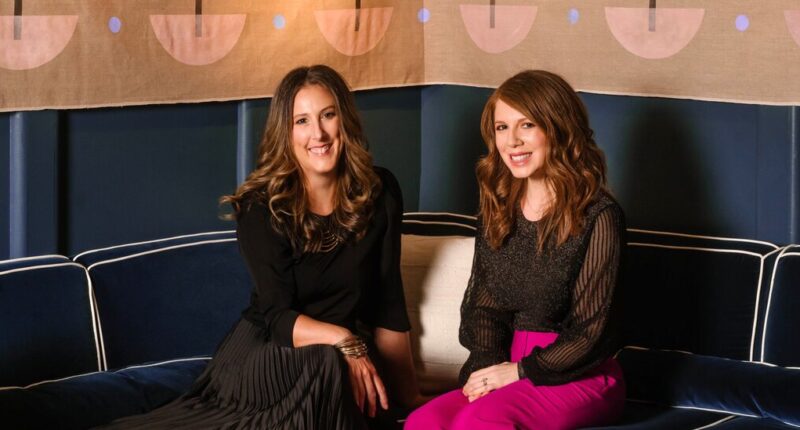
For admission to Chief, a women’s leadership network, members pay up to $7,900. That gets them executive coaching, big-name speaker sessions, a Rolodex of female executives and, for an extra cost, access to five sleek clubhouses. Chief is essentially an “old boys’ club” — for the ladies. The venture capital-backed company has grown to over 20,000 members and over $1 billion in value since it started in 2019.
This month, in social media battles, some of its members have begun to ask: What does their club of high-powered women stand for? On LinkedIn, some Chief members have criticized the community’s approach to racial diversity and its response to political issues like the overturn of Roe v. Wade, and some have announced plans to quit.
Chief’s founders, Lindsay Kaplan and Carolyn Childers, say they’ve donated to abortion access groups, issued statements in the wake of racial violence and acted on their members’ feedback, while remaining focused on the company’s primary goal, which is women’s corporate advancement. But in conversations with two dozen current and former Chief members, some said they wanted the network to be more socially and politically engaged.
“The price tag is really too high for people to not care deeply about how they’re responding to these significant issues,” said Nika White, 47, the president of a diversity, equity and inclusion consultancy who decided not to renew her Chief membership this month.
Other members defended the organization, like Amani Duncan, formerly a senior vice president at ViacomCBS. “I was shocked when I started seeing the posts on LinkedIn,” Ms. Duncan, 52, said. “I didn’t realize how much I needed Chief until I joined. It was kind of kismet.”
It’s a she-said, she-said story. But it’s one that raises a thorny and long-simmering question: Is amassing power for corporate women a worthy goal in itself? Or should female executives, as they ascend, prioritize spotlighting the many social and economic issues holding back more marginalized women?
The recent turmoil at Chief began on International Women’s Day, in early March, when a member of the network, Denise Conroy, declared on LinkedIn that she was leaving Chief and accused the group of sidestepping political issues and ghosting women of color who applied for membership. (Ms. Conroy, 51, later acknowledged that she had been reprimanded internally for trying to sell tickets on Chief’s platform to an external workshop she was running, which ran counter to the company’s policies.) Her post, which generated more than 5,000 reactions, incited larger debate within Chief about the community’s future.
Rachel Hassall, a supply chain executive, is one of the Chief members who chose to leave the organization this month. She had recently participated in a discussion that Ms. Conroy hosted about the book “White Women: Everything You Already Know About Your Own Racism and How to Do Better,” where some Chief members shared frustrations with the organization’s approach to racial inclusivity. Ms. Hassall started to feel ashamed about her membership.
“I did not join thinking this was a political or social revolution,” said Ms. Hassall, 37. “But when I got in and realized how much power is in there, then I was like, Why aren’t we doing more?”
Chief’s founders told The New York Times that their mission was advancing women’s leadership in business, not social advocacy. They also pointed to the statements Chief released to the community after the killing of George Floyd, the shootings targeting Asian Americans near Atlanta-area spas and other incidents of racial violence, as well as to donations it has made to racial justice nonprofits. Thirty-three percent of Chief’s members are women of color. And the founders said the organization treated all applicants the same. It sends only acceptance emails, not rejections.
“At Chief, we have always wanted to make sure that our values were clear,” Ms. Childers said. “But we’re also not a social activism organization.”
Chief’s annual membership costs $5,800 for vice presidents and $7,900 for C-suite executives; 70 percent of members have their fees covered by employers. Membership brings access to executive coaching, career workshops, in-person meet-ups, a job board and speaker sessions with high-profile women like Michelle Obama and Amal Clooney, as well as entry to chic clubhouses in New York, Chicago, Los Angeles, San Francisco and London for an additional cost. Women can apply or be nominated for membership, and for admission Chief considers their titles as well as the size of their companies and the teams they manage.
“It was challenging to climb the corporate ladder as a first-generation immigrant,” said Gabby Hirata, 34, the chief executive of Diane von Furstenberg. “Chief gave me the exposure to observe how the S.V.P.s and C-levels carry themselves.”
But some of its members now argue that Chief’s group coaching is better suited to supporting the professional experiences of white women. Sibil Patri, 41, a vice president at an asset management company, recalled that when she was first accepted to Chief she felt a high that she’d been chasing since adolescence when she was cut from the cheerleading team: the sense of being in the cool girls’ club.
It didn’t take long for her sense of belonging to dissipate. Sitting in group coaching sessions, she got the feeling that the white women couldn’t relate to the professional problems that the women of color were sharing. Last year, she quit. She emailed Chief then to say the network should have a “stronger curated experience for women of color.”
“Chief is a club for white women,” Ms. Patri said. “If you are a group built by white women to help white women without centering any of the other intersections, that’s fine, but you need to be willing to own that.”
“We have really tried to ensure that there’s no ‘onlys’ within those groups,” Ms. Childers said of Chief’s coaching groups, adding that their guides are trained to facilitate difficult conversations. “There is a lot of training that we try to put in place — we’ve been doing inclusivity training specifically with them. But there’s more to do.”
The company said retention rates for women of color this year were four percentage points higher than for white women.
And some women of color in the community said they didn’t share the inclusivity critiques. Sandhya Jain-Patel joined the network in 2019. She enjoyed what members referred to as “Chief disease,” which was the zealous support the women gave each other for entrepreneurial ideas batted around at the clubhouses.
“Somebody would be like, ‘I want to do this,’ and everybody would be like, ‘Sure, I’ll help you,’” Ms. Jain-Patel, 48, recalled. “I remember saying to somebody one day: ‘I have this website idea. This is what I really want to do.’ She grabbed my phone, pulled up GoDaddy and was like, ‘I’ll register it right now.’”
Ms. Jain-Patel, though, does have her own frustrations with Chief. “Aside from this core group, what are you doing for us?” she said. “Why are you charging us so much money?”
When Chief’s founders, Ms. Kaplan, 38, and Ms. Childers, 43, were building their own careers, access to an executive women’s network seemed like a resource worth paying for — not to mention coaching, which they pointed out can cost tens of thousands of dollars. Just over 10 percent of Fortune 500 companies are run by women. Ms. Childers, who was previously a vice president at the company Handy, recalled fielding constant pleas for advice from young female colleagues earlier in her career. Ms. Kaplan had worked at a start-up where she was the only senior woman, and had to help design her own maternity leave policy.
The two met in 2017 at a networking event in the basement of an Italian restaurant in New York City, and two years later they started the executive women’s network. Initially, they thought they would accept members only near their clubhouses. But then the pandemic hit, much of their programming went virtual and they decided to expand their reach.
The network exploded — its waiting list swelled to 60,000 — as did its valuation, propelling Chief to become one of the fastest-growing female-founded unicorns. Last year, Chief secured $100 million in a Series B round led by Alphabet’s growth fund, CapitalG.
Chief is a girl power endeavor drenched in girl power lingo. (Its members love to cite a particular Madeleine Albright quotation.) But its ascent came after the peak era of the so-called Girlboss, a term popularized in 2014 by Sophia Amoruso, the founder of the fashion company Nasty Gal, which went bankrupt in 2016.
Before Chief there was “Lean In,” a best-selling book by the former Meta executive Sheryl Sandberg, which spawned the creation of thousands of female support circles — and then faced backlash for its focus on women turbocharging their careers. There was also the Wing, a women’s co-working space, whose chief executive, Audrey Gelman, stepped down in 2020 after facing criticism from Black staff members, and which shuttered in 2022.
Leading a company geared toward women’s empowerment became especially fraught last year, when the Supreme Court ended nearly 50 years of federally protected abortion rights.
Ms. Kaplan and Ms. Childers said their organization’s mission was to promote women’s leadership, and they feel that reproductive choice is inextricable from that. So after the Dobbs v. Jackson ruling Chief joined Don’t Ban Equality, a coalition of businesses opposing abortion restrictions; donated $250,000 to organizations supporting reproductive choice; hosted educational programs; and expanded abortion-related health care benefits for employees. The company also hosted “listening sessions” for members, which to Ms. Conroy felt like “the scene from ‘Mean Girls’ where everybody gathered in the gym and shared their feelings.”
But some of Chief’s members wanted to see the company do more to address Roe v. Wade’s overturn in a sustained and public way. A group of Chief members sent an email to the founders listing actions they wanted to see Chief take, including putting some of Chief’s advertising money toward statements on reproductive health and even supporting the idea of a “Day Without Women” strike.
“Not being willing to take a very strong stance on women’s choice was for me the proverbial nail in the coffin,” said Lisa Gralnek, 45, a founder of Chief’s internal social impact group, Moving the Needle, who joined the network in 2019 and chose not to renew her membership last year.
Other Chief members defended the company’s relative restraint. “If I wanted to be politically active, I would join an organization with that mission,” said Michelle Ferguson, 65, who joined Chief in 2019 and came up with the idea for her book (“Women Mentoring Women”) because of conversations at the clubhouse.
With 20,000 members of the leadership community, and nearly as many opinions about precisely what its values should be, Chief is facing a period of tumult.
“When you have a brand that has a really strong emotional connection, people take it personally,” said Kenneth Chenault, the former chief executive of American Express and a board member of Chief.
Ms. Kaplan and Ms. Childers have spent this month reflecting on responses from members and holding listening sessions.
“As Madeleine Albright — who I adore — said, there’s a special place in hell for women who don’t support other women,” Ms. Gralnek said. “I have no interest in seeing these girls fail. I just think they have to start listening to someone other than V.C.s and their own egos.”
Source: | This article originally belongs to Nytimes.com









